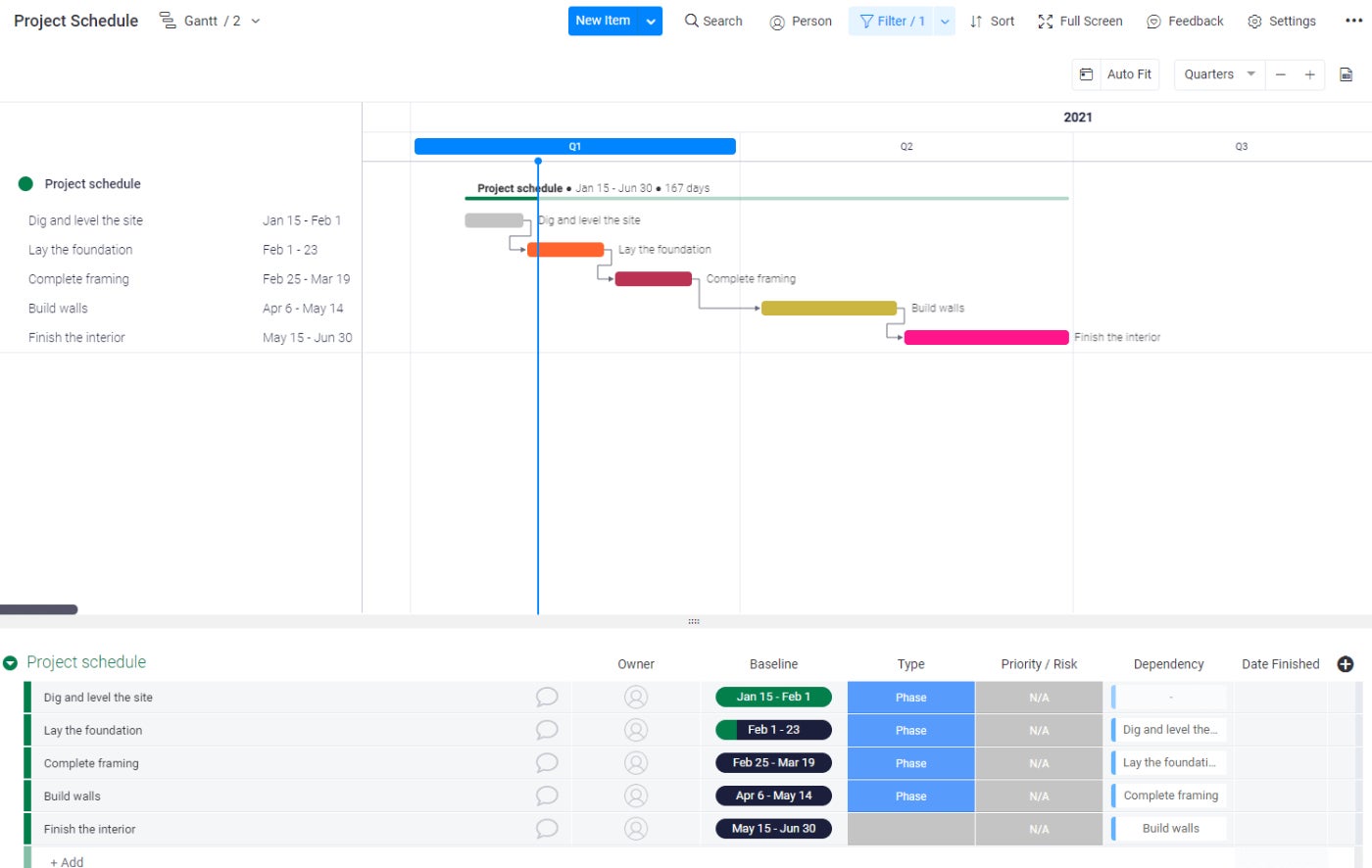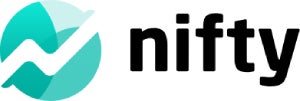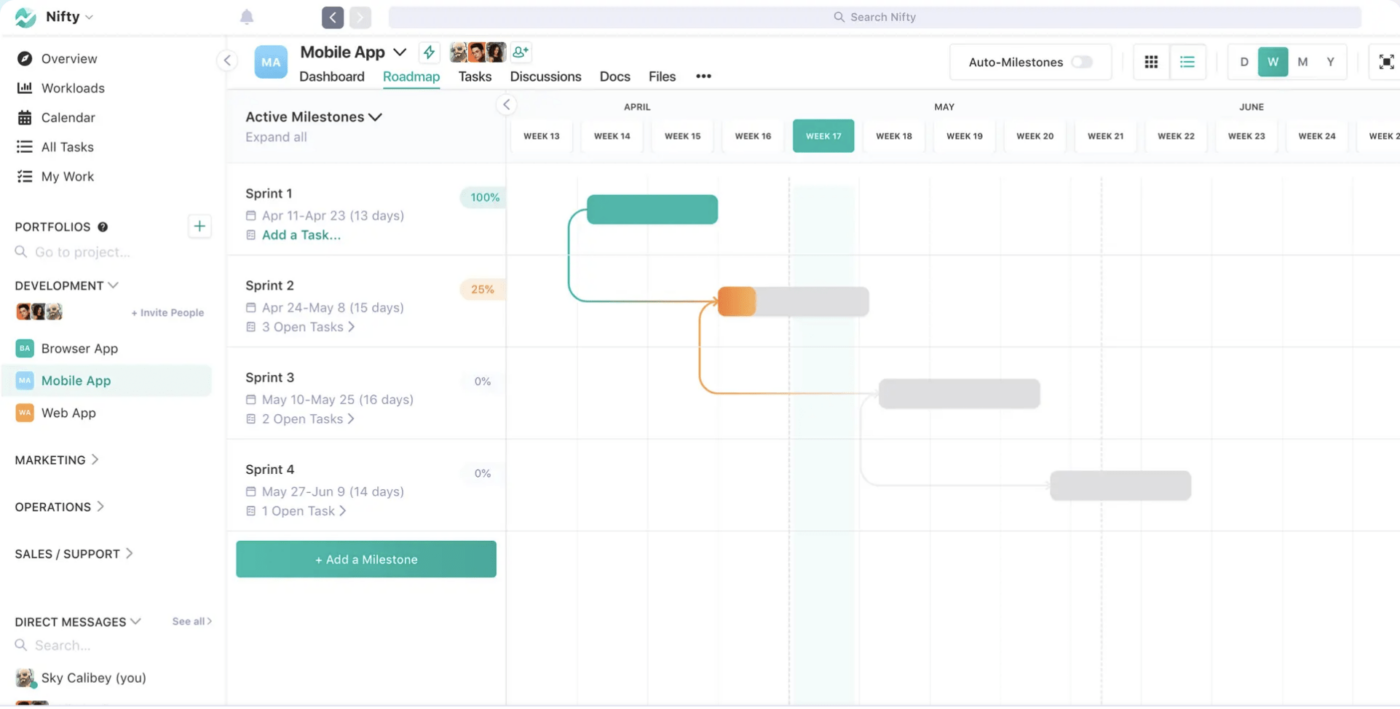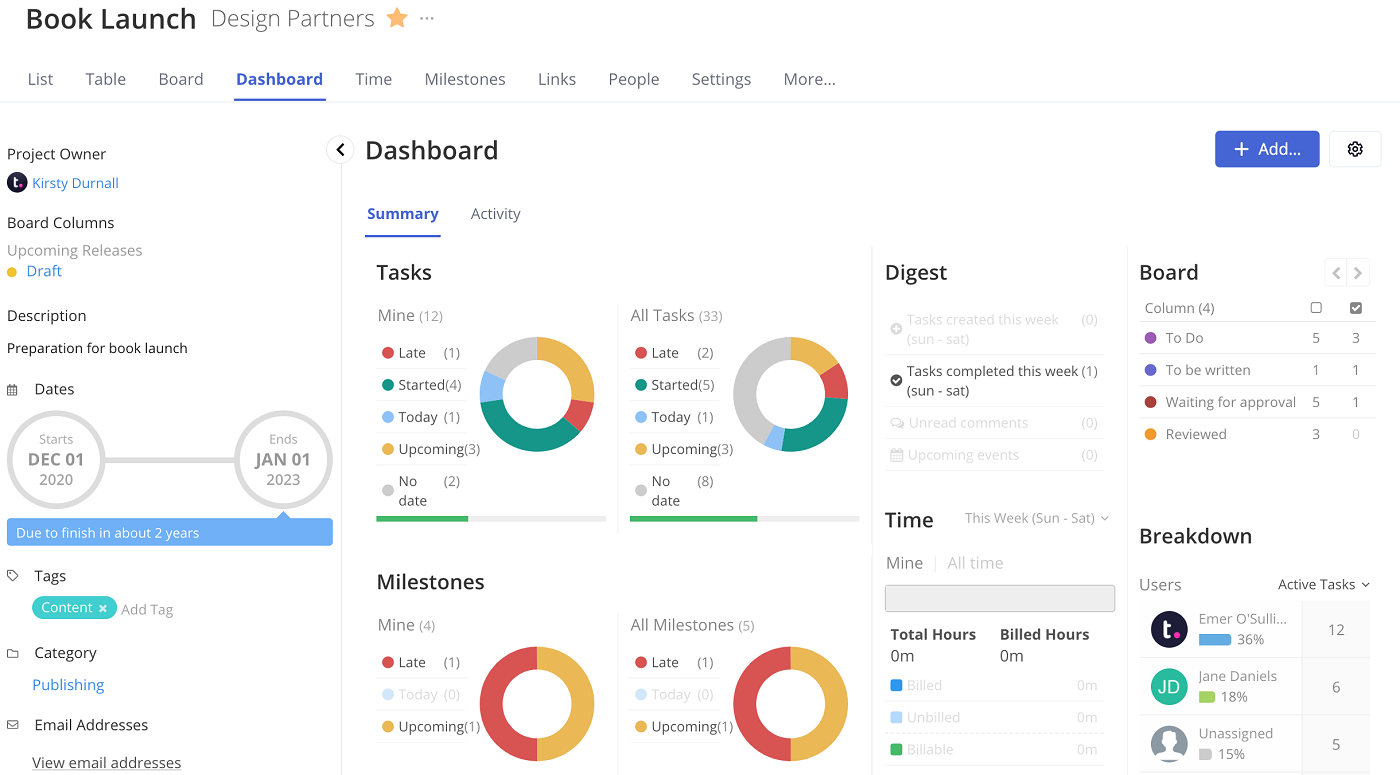- Best for team collaboration and communication: Wrike
- Best for teams of all sizes: monday.com
- Best for spreadsheet users: Smartsheet
- Best for customization: ClickUp
- Best for working on multiple projects: Nifty
- Best for existing users of Microsoft products: Microsoft Project
- Best for client-facing projects: Teamwork
- Best for reporting and analytics: Hive
Using a waterfall project management methodology helps you stay organized and clearly define the objectives of each phase of the project. Successfully executing waterfall project management can be easier if you use specialized tools.
We have compiled a list of the best software for waterfall project management. We’ll also share the pros, cons, standout features and pricing of each software. In addition, we share some tips on what features to consider and how to choose the best software for your organization.
Top waterfall project management tools comparison
This table provides a quick view of how the top waterfall project management solutions compare in terms of core functionality and starting price.
| Free plan | Starting price (per month) | Task sequencing and dependencies | Resource management | Gantt charts | Team collaboration | Customizable workflows | |
|---|---|---|---|---|---|---|---|
| Wrike | Yes | $9.80 per user | Yes | Yes | Yes | Yes | Yes |
| monday.com | Yes | $12 per user | Yes | Yes | Yes | Yes | Yes |
| Smartsheet | Yes | $9 per user | Yes | Yes | Yes | Yes | Yes |
| ClickUp | Yes | $10 per user | Yes | Yes | Yes | Yes | Yes |
| Nifty | Yes | $49 for up to 10 members | Yes | Yes | Yes | Yes | Yes |
| Microsoft Project | No | $10 per user | Yes | Yes | Yes | Limited | Yes |
| Teamwork | Yes | $8.99 per user | Yes | Yes | Yes | Yes | Yes |
| Hive | Yes | $1.50 per user | Yes | Yes | Yes | Yes | Yes |
Wrike: Best for team collaboration and communication

Wrike is a versatile project management tool that supports water project management. It offers a wide range of features and the sequential flow required by the waterfall project management approach. The top features of Wrike include its outstanding collaboration tools, multiple project views, AI tools and data security features.
Pricing
A 14-day free trial is available.
- Free: $0 for unlimited users.
- Team: $9.80 per user per month, billed annually. Monthly billing isn’t available.
- Business: $24.80 per user per month, billed annually. Monthly billing isn’t available.
- Enterprise: Contact Wrike’s sales team for pricing information.
- Pinnacle: Contact Wrike’s sales team for pricing information.

Standout features
- Wrike AI tools: The AI tools in Wrike help assist in project planning, scheduling and tracking by predicting risk factors to help highlight any upcoming bottlenecks or hurdles to the project’s progress.
- Wrike Lock: Wrike workspace data is protected with additional layers of encryption through the Wrike Lock feature.
- Collaboration tools: You have access to a variety of collaboration tools, such as cross-tagging, internal and guest approvals, proofing and live document editor.
Top Wrike integrations
You can connect Wrike with over 400 third-party apps. Its top integrations include:
- Airtable: It lets users sync data between Wrike and Airtable.
- Box: The Box integration allows users to easily attach files and folders from Box directly to their Wrike tasks or projects.
- HubSpot: By integrating Wrike with HubSpot, users can sync contacts, deals and tasks between the two platforms.
- Mailchimp: The integration with Mailchimp allows users to sync campaigns, leads and subscribers with Wrike.
Pros and cons
| Pros | Cons |
|---|---|
| Organized UI | Expensive for solo users and small teams that need Business plan features |
| Robust team collaboration features | Delayed notifications with some integrations |
| Enterprise-level data security tools | |
| Plenty of in-app learning content |
Why we chose Wrike
Wrike enables seamless collaboration among team members, allowing stakeholders to easily communicate, share updates and track progress. This is essential in waterfall project management, where different teams and stakeholders need to work together towards a common goal.
For more information, read the full Wrike review.
monday.com: Best for teams of all sizes

monday is one of the most customizable and flexible project management tools on this list. It supports various project management methodologies, including waterfall project management. You can create different workflows to align with the different phases of a waterfall project. The multiple project views and advanced reporting and analytics allow you to derive actionable insights for informed decision making.
Pricing
A free trial is available.
- Individual: $0 for up to two seats.
- Basic: $9 per seat per month, billed annually, or $12 per seat billed monthly.
- Standard: $12 per seat per month, billed annually, or $14 per seat billed monthly.
- Pro: $19 per seat per month, billed annually, or $24 per seat billed monthly.
- Enterprise: Quotes are available upon request.

Standout features
- Automation tools: monday work management offers a variety of automation tools to minimize recurring or repetitive tasks for waterfall project management.
- Custom forms: Customize and share surveys for data collection via the WorkForms tool.
- Advanced reporting and analytics: Enables data-driven decision making, so project leaders can keep up with task progress and team performance.
- Variety of integrations: Integrations for developers, creative teams, CRM and other functions.
monday work management top integration
The platform offers integrations with over 200 tools.
- Development tools: Some of the dev tools that can be connected include GitHub, Jira Cloud, PagerDuty and GitLab.
- Marketing: HubSpot, Mailchimp, SurveyMonkey and Google Ads are some of the top marketing tools monday integrates with.
- Collaboration: This includes Zoom, Google Drive, Microsoft Teams and Slack.
- For communication: You can integrate monday with Outlook, Gmail, Zendesk and Twilio.
Pros and cons
| Pros | Cons |
|---|---|
| Highly visual interface | Steep learning curve for advanced features |
| Wide range of integrations | Default notification settings can be overwhelming |
| Powerful automation engine | Data reconciliation issues after data import |
| Highly customizable |
Why we chose monday work management
It earned a top spot as one of the best waterfall PM tools due to its ability to accommodate teams of different scales and complexities. Whether it’s a small team or a large enterprise-level project, Monday is designed to handle the needs and requirements of any team.
For more information, read the full monday work management review.
Smartsheet: Best for spreadsheet users

The spreadsheet-based interface allows Smartsheet users to perform task management in a sequential manner, which is vital for waterfall project management. It also provides access to resource management, a variety of prebuilt templates and workflow automation tools to tailor the software for waterfall project management methodologies.
Pricing
- Free plan for up to one user and two editors.
- Pro plan: $9 per month per user billed yearly, or $12 per month per user billed monthly.
- Business plan: $19 per month per user billed yearly, or $24 per month per user billed monthly.
- Enterprise plan: Customized pricing.

Standout features
- Resource management: Helps mobilize the best team for the job and ensures the waterfall project remains on schedule and within the scope of the budget.
- Prebuilt templates: Variety of templates, including templates for to-do lists, Gantt charts, Agile project management and event planning.
- Intelligent workflows: Automate multistep processes for waterfall project management across platforms.
Top Smartsheet integrations
Smartsheet integrates with about 104 third-party apps, including:
- HubSpot: Sync customer and account information between HubSpot and Smartsheet automatically without any manual data entry imports.
- Slack: Receive Smartsheet notifications and reminders as direct messages.
- Microsoft Teams: Microsoft Teams customers can add Smartsheet sheets, dashboards and reports as ‘Tabs’ within a Team channel.
Pros and cons
| Pros | Cons |
|---|---|
| Familiar user interface for spreadsheet users | Issues with autosave feature and data update in real-time |
| Extensive range of prebuilt templates | Light on integrations |
| Highly customizable | Spreadsheet-reliant interface |
Why we chose Smartsheet
For individuals or teams who are already familiar with traditional spreadsheet tools, the learning curve for using Smartsheet is significantly reduced. The tool stands out for its ability to handle complex project management tasks while maintaining simplicity, allowing you to easily create and manage tasks, assign responsibilities and track progress using familiar spreadsheet-like formulas and calculations.
For more information, read the full Smartsheet review.
ClickUp: Best for customization

ClickUp is a comprehensive all-in-one software for project tracking, team collaboration and productivity. The hierarchical setup of tasks, resource management capabilities and multiple project views make ClickUp ideal for waterfall project management. In addition, users get access to advanced reporting and document management tools, making it a highly capable tool for waterfall project management.
Pricing
- Free: No cost for unlimited free plan members.
- Unlimited: $7 per person per month, billed annually, or $10 per person billed monthly.
- Business: $12 per person per month, billed annually, or $19 per person billed monthly.
- Enterprise: Contact ClickUp’s sales team for pricing information.

Standout features
- Custom statuses: Helps define specific stages of waterfall project management.
- Multiple project views: Access to list views, boards, charts, mind maps, calendars and other views.
- Goal and milestone features: Ensures teams are in line to hit their objectives.
- Automation and integrations: Enables streamlined project planning with automation capabilities and integrations with over 1,000+ apps.
Top ClickUp integrations
- Slack: Integrate Slack to create and manage ClickUp tasks without leaving the conversation.
- GitHub: Create branches and pull requests straight from ClickUp.
- Harvest: Track time and associate the time with the ClickUp task.
- Google Drive, OneDrive and DropBox: These connectors let you search and attach files to ClickUp tasks without leaving the platforms.
Pros and cons
| Pros | Cons |
|---|---|
| Clear task hierarchy and structure | Limited customization on visuals |
| Feature-rich free plan | Occasional slow loading or lag when moving pages |
| Outstanding support for Agile project management | |
| User-friendly interface and onboarding experience |
Why we chose ClickUp
ClickUp passed our assessments due to its high level of customizability, as it allows teams to adapt the software to fit their specific workflow and project management process. This flexibility enables users to organize and manage their projects to best meet their needs.
For more information, read the full ClickUp review.
Nifty: Best for working on multiple projects

Nifty is a popular project management and productivity software that can be adapted for waterfall project management. While Nifty may not have built-in or specialized tools for waterfall project management, it does offer basic functionality. The key advantage of Nifty is its ease of use, making it work for users of all technical levels.
Pricing
A 14-day free trial is available.
- Free plan with a maximum of two active projects.
- Starter plan: $39 per member per month, billed annually, or $49 per member when billed monthly. For up to 10 members.
- Pro plan: $79 per member per month when billed annually and $99 per member when billed monthly. For up to 20 members.
- Business plan: $124 per member per month, billed annually and $149 per member when billed monthly. For up to 50 members.
- Unlimited: $399 per member per month, billed annually and $499 per member when billed monthly. For unlimited team members.

Standout features
- Time tracking: Nifty offers a comprehensive time-tracking tool with a detailed breakdown of logged hours and other data on team productivity.
- Nifty Project Portfolio: This feature is ideal for users that manage or work on multiple projects because a centralized hub offers better visibility on multiple projects.
- Milestones: With this feature, you get access to Gantt charts, task dependencies and other useful tools for waterfall project management.
Top Nifty integrations
- Slack: Allows you to manage your team’s work between Nifty and Slack, without having to constantly switch tools.
- Github: Automatically track your commits, merges and pull requests – all from within your task activity feeds.
- Google Drive and Calendar: Create and upload Google Docs, spreadsheets and files directly into your Nifty projects.
- Microsoft Suite: Upload files from OneDrive, import docs from 365 and sync your events as tasks from Outlook Calendar.
Pros and cons
| Pros | Cons |
|---|---|
| Specialized tools for development and product teams | Limited project templates |
| Simple to use for users of all technical levels | Third-party integrations aren’t as seamless as other competitors |
| Impressive collaboration tools |
Why we chose Nifty
Nifty stands out as one of the best waterfall project management software due to its strong project portfolio management capabilities. It excels in helping teams efficiently work on multiple projects simultaneously. Nifty delivers advanced features that allow users to track and manage multiple projects from a single centralized platform.
For more information, read the full Nifty review.
Microsoft Project: Best for existing users of Microsoft products

MS Project offers a variety of powerful tools to support waterfall project management, including resource management, multiple project views and advanced reporting and analytics. While MS Project may not have the most intuitive user interface, it does allow for sequential flow and a structured approach to project management.
Pricing
Microsoft Project can be used as a standalone product or added to your Office 365 subscription.
Cloud-Based plans
- Project plan 1: $10 per user per month.
- Project plan 3: $30 per user per month.
- Project plan 5: $55 per user per month.
On-Premises plans
- Project Standard 2021: $719.99 one-time purchase.
- Project Professional 2021: $1,409.99 one-time purchase.]
- Project Server: Custom quote.

Standout features
- Project views: Views offer a variety of visualization tools for project planning, scheduling and tracking.
- Resource management: Managers can assign tasks, view resource availability and track progress to maximize project efficiency.
- Seamless integration with Microsoft products: It’s quick and easy to integrate MS Project with other Microsoft applications.
Top Microsoft Project integrations
- Microsoft SharePoint: Integration with SharePoint enables teams to store and share project-related documents, track version history and collaborate on files. It also helps in maintaining centralized project information and improves team collaboration.
- Power BI: This integration allows project managers to create interactive dashboards and reports, visualize project data and gain insights into project performance.
Pros and cons
| Pros | Cons |
|---|---|
| All-in-one tool for managing all aspects of a project | Steep learning curve |
| Powerful reporting and analytics tools | Light on team collaboration tools |
| Deep integration with Microsoft products | Limited integrations outside the Microsoft ecosystem |
Why we chose Microsoft Project
Microsoft Project has a long history and established reputation as a reliable and comprehensive project management tool and its on-premise version makes it a suitable candidate for businesses that prefer to manage the software they use in-house for security reasons. It offers a wide range of features specifically designed for waterfall project management, such as Gantt charts, critical path analysis and resource management capabilities.
For more information, read the full Microsoft Project review.
Teamwork: Best for client-facing projects

Teamwork provides a centralized platform for tasks, timelines, communication and document sharing, allowing team members to work together seamlessly.
Teamwork offers several tools for waterfall project management. This includes the ability to define task dependencies to ensure proper sequencing and a variety of project views to identify critical paths. Teamwork also offers robust reporting and analytics tools, including customized reports. All these features are accessible through a user-friendly interface.
Pricing
- Free forever: Free plan for up to five users.
- Starter: $5.99 per user per month billed annually, or $8.99 per user billed monthly.
- Deliver: $9.99 per user per month billed annually, or $13.99 per user billed monthly.
- Grow: $19.99 per user per month billed annually, or $25.99 per user billed monthly.

Standout features
- Project tracking and budgeting: Allows managers and team leaders to track waterfall project progress and costs.
- Reporting and analytics: Access to a variety of reports, including workload management, resource utilization, billing and invoicing.
- Collaboration tools: Allows users to work together on projects with built-in tools such as chat and document management.
Top Teamwork integrations
- Slack: By integrating Slack with Teamwork.com, you can automatically turn requests into tasks or messages.
- HubSpot: With Teamwork.com’s HubSpot automation, you can seamlessly connect Teamwork.com to your HubSpot account, enabling you to create projects and tasks automatically.
- MS Teams: You can view and interact with your Teamwork.com projects in Microsoft Teams using tabs.
Pros and cons
| Pros | Cons |
|---|---|
| User-friendly interface | Initial setup is challenging |
| Ability to facilitate client collaboration | Starter plan feels light on core features |
| Efficient team management features | |
| Flexible notification settings |
Why we chose Teamwork
We selected Teamwork for its intuitive project planning features, including Gantt charts, milestones and dependencies, which help teams visualize project timelines and identify potential bottlenecks.
For more information, check out our full Teamwork review.
Hive: Best for reporting and analytics

From Gantt charts to task dependencies, Hive is packed with features for waterfall project management. Hive is known for its advanced reporting and analytics features, including customized reports, performance analytics, workload analysis and real-time dashboards. Along with the powerful tools, you get an intuitive user interface and a variety of customization options.
Pricing
- Free: $0 for up to 10 users.
- Starter: $1 per user per month, billed annually, or $1.50 per user per month, billed monthly.
- Teams: $3 per user per month billed annually, or $5 per user billed monthly.
- Enterprise: Contact Hive’s sales team for pricing information.

Standout features
- Built-in messaging system: The native messaging tool allows for seamless communications and collaboration, offering a variety of tools, including group chats.
- Project summaries: The summary view allows users to visualize progress across all tasks or projects.
- Proofing and approval tools: Managers and team leaders can proof and approve files from within the software.
Top Hive integrations
- Google Drive: Lets you upload and attach files to actions, projects, action templates and share them in messages.
- Zoom: Use Zoom for video conferencing by integrating your account to create ad-hoc meetings directly from Hive messaging.
- Slack: You can share Hive actions in Slack and quickly create actions using slash commands.
Pros and cons
| Pros | Cons |
|---|---|
| Powerful reporting and analytics tools | Some core features cost extra, including analytics |
| Visually appealing user interface | Limited control of user permissions |
| Accessible and responsive customer support | Mobile app has significantly less functionality |
Why we chose Hive
Aside from its comprehensive waterfall project management features, Hive stands out as one of the best options due to its robust reporting and analytics capabilities. Hive provides advanced analytics that helps identify bottlenecks, monitor team productivity and optimize resources. It is also the most affordable tool on our list.
For more information, read the full Hive review.
Key features of waterfall project management software
Task sequencing and dependencies
With waterfall project management, you need software that allows you to set up task sequencing and dependencies to ensure they get completed in a specific order. This feature also allows users to ensure all prerequisites are completed in a project phase before the project proceeds to the next. Task dependencies are also useful in allowing team leaders and project managers to perform impact analysis of different project scenarios.
Resource management
Resource management tools ensure smooth project flow, which is vital for the success of waterfall project methodology. With this feature, you can maximize the utilization of resources while making sure none of the team members are overburdened. Advanced resource management tools also offer cost control through budget planning and analysis to cut unnecessary expenses due to inefficient allocation of resources.
Gantt charts
While Gantt charts are useful in all project management software, they’re particularly important for waterfall project management as they provide a visual representation of project progress. This feature also helps you visualize critical paths and project timelines. Gantt charts also help with other features of waterfall project management, such as resource management and project costing.
Advanced reporting and analytics
Advanced reporting and analytics allow users to generate reports and gather valuable insights on progress, risk assessment and other metrics vital to the success of waterfall project management methodology. Some tools offer customized reporting, so users can tailor the reports according to their specific needs and adapt to changing requirements as the waterfall project goes through different phases.
How do I choose the best waterfall project management tool for my business?
Waterfall PM tools need to offer some core functionality: task sequencing and dependencies, resource allocation and a few other features. With waterfall project management methodology, you need to ensure the tasks or project phases get completed in a specific order — and for that, you need software that offers a structured and organized layout.
You also need the software to offer a variety of project views and the ability to optimize resource allocation. If you are managing a project portfolio or a complex project, you may also need advanced reporting and analytics tools. Ultimately, you’ll have to consider your top priorities and business needs to choose the best waterfall PM software.
Methodology
As one of the first steps to evaluating different software, we established criteria for what is expected from a top waterfall project management solution. This included various parameters and aspects of the software, including its user interface, scalability, core features, advanced tools, pricing plans and more. We also included customer reviews and testimonials in our assessment of the best waterfall project management tools.

